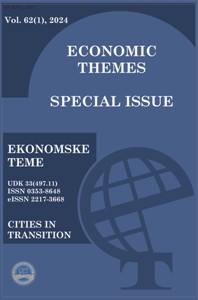Economic Themes (2024) 62 (1) 3, 45-66
Dušan Ignjatović, Nikola Miletić, Bojana Zeković, Nataša Ćuković Ignjatović
Abstract: For achieving transition towards a climate neutral, cleaner and healthier environment we must tackle the issues which contribute mostly to climate change and pollution, through fossil fuels excessive consumption and inefficient use of other resources. Construction and operation of buildings is certainly one of these issues, with estimation that buildings consume about 40% of the total energy (EU). One of the strategies that is considered most effective in making the building sector more resource and energy efficient is refurbishment of old buildings, which no longer meet criteria for achieving adequate comfort with minimal energy use. Their refurbishment, opposed to their demolition and construction of new ones, brings numerous environmental benefits, and also drives the transitions of entire cities and communities towards a more resilient and better environment. Recent policies (Energy Efficiency Directives, EU Green Deal, The New European Bauhaus initiative) also highlight the importance of building refurbishment and set goals for ambitious refurbishment rates for the entire building stock. At the same time, they highlight the importance of refurbishment of public buildings, because of the positive implications it has in terms of showcase and educational purposes. This paper presents the case study of refurbishment options for a characteristic municipal building, through cost-benefit analysis of different refurbishment scenarios.
Keywords: Energy efficiency; building refurbishment; cost-benefit analysis
COST-BENEFIT ANALYSIS OF BUILDING ENERGY REFURBISHMENT – CASE STUDY OF A MUNICIPAL PUBLIC BUILDING
Dušan Ignjatović, Nikola Miletić, Bojana Zeković, Nataša Ćuković Ignjatović
Abstract: For achieving transition towards a climate neutral, cleaner and healthier environment we must tackle the issues which contribute mostly to climate change and pollution, through fossil fuels excessive consumption and inefficient use of other resources. Construction and operation of buildings is certainly one of these issues, with estimation that buildings consume about 40% of the total energy (EU). One of the strategies that is considered most effective in making the building sector more resource and energy efficient is refurbishment of old buildings, which no longer meet criteria for achieving adequate comfort with minimal energy use. Their refurbishment, opposed to their demolition and construction of new ones, brings numerous environmental benefits, and also drives the transitions of entire cities and communities towards a more resilient and better environment. Recent policies (Energy Efficiency Directives, EU Green Deal, The New European Bauhaus initiative) also highlight the importance of building refurbishment and set goals for ambitious refurbishment rates for the entire building stock. At the same time, they highlight the importance of refurbishment of public buildings, because of the positive implications it has in terms of showcase and educational purposes. This paper presents the case study of refurbishment options for a characteristic municipal building, through cost-benefit analysis of different refurbishment scenarios.
Keywords: Energy efficiency; building refurbishment; cost-benefit analysis

